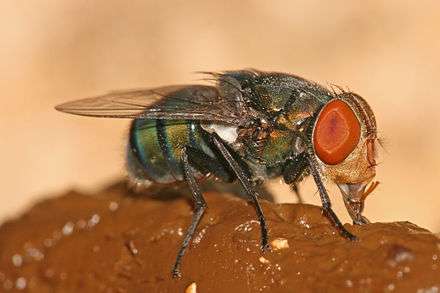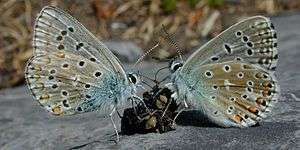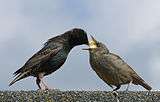Coprophagia
Coprophagia (/ˌkɒprəˈfeɪdʒiə/)[1] or coprophagy (/kəˈprɒfədʒi/) is the consumption of feces. The word is derived from the Greek κόπρος copros, "feces" and φαγεῖν phagein, "to eat". Coprophagy refers to many kinds of feces-eating, including eating feces of other species (heterospecifics), of other individuals (allocoprophagy), or one's own (autocoprophagy) – those once deposited or taken directly from the anus.[2]

In humans, coprophagia has been described since the late 19th century in individuals with mental illnesses and in unconventional sexual acts.[3] Some animal species eat feces as a normal behavior, in particular lagomorphs, which do so to allow tough plant materials to be digested more thoroughly by passing twice through the digestive tract. Other species may eat feces under certain conditions.
Coprophagia by humans
As a supposed medical treatment
Ttongsul, or "feces wine", has been used in old Korean medicine. Ideally, a child's excrement is used in the preparation with alcohol content up to 9% by volume.[4]
Centuries ago, physicians tasted their patients' feces, to better judge their state and condition.[5]
Lewin reported, "... consumption of fresh, warm camel feces has been recommended by Bedouins as a remedy for bacterial dysentery; its efficacy (probably attributable to the antibiotic subtilisin from Bacillus subtilis) was anecdotally confirmed by German soldiers in Africa during World War II".[6]
As a paraphilia
Coprophilia is a paraphilia (DSM-5), where the object of sexual interest is feces, and may be associated with coprophagia. Coprophagia is sometimes depicted in pornography, usually under the term "scat" (from scatology).[7] A notorious example of this is the pornographic shock video 2 Girls 1 Cup. [8] The 120 Days of Sodom, a 1785 novel by Marquis de Sade, is full of detailed descriptions of erotic sadomasochistic coprophagia.[9] Austrian actor and pornographic director Simon Thaur created the series "Avantgarde Extreme" and "Portrait Extrem", which explores coprophagy, coprophilia, and urolagnia. GG Allin, an American shock rock singer-songwriter, often featured coprophagy in his performances.
Coprophagia has also been observed in some people with schizophrenia[10] and pica.[11]
In literature
François Rabelais, in his classic Gargantua and Pantagruel, often employs the expression mâche-merde or mâchemerde, meaning "shit-chewer". This, in turn, comes from the Greek comedians Aristophanes and particularly Menander, who often use the term skatophagos (σκατοφάγος).[12]
Thomas Pynchon's award-winning 1973 novel Gravity's Rainbow contains a detailed scene of coprophagia.[13]
Modern Russian writer Vladimir Sorokin's novel Norma describes a society where coprophagia is institutionalized and mandatory.
Coprophagia by nonhuman animals
By invertebrates

Coprophagous insects consume and redigest the feces of large animals. These feces contain substantial amounts of semidigested food, particularly in the case of herbivores, owing to the inefficiency of the large animals' digestive systems. Thousands of species of coprophagous insects are known, especially among the orders Diptera and Coleoptera. Examples of such flies are Scathophaga stercoraria and Sepsis cynipsea, dung flies commonly found in Europe around cattle droppings. Among beetles, dung beetles are a diverse lineage, many of which feed on the microorganism-rich liquid component of mammals' dung, and lay their eggs in balls composed mainly of the remaining fibrous material.[14]
Termites eat one another's feces as a means of obtaining their hindgut protists. Termites and protists have a symbiotic relationship (e.g. with the protozoan that allows the termites to digest the cellulose in their diet). For example, in one group of termites, a three-way symbiotic relationship exists; termites of the family Rhinotermitidae, cellulolytic protists of the genus Pseudotrichonympha in the guts of these termites, and intracellular bacterial symbionts of the protists.[15]
By vertebrates
Domesticated and wild mammals are sometimes coprophagic, and in some species, this forms an essential part of their method of digesting tough plant material.
Some dogs may lack critical digestive enzymes when they are only eating processed dried foods, so they gain these from consuming fecal matter. They only consume fecal matter that is less than two days old which supports this theory.[16]
Species within the Lagomorpha (rabbits, hares, and pikas) produce two types of fecal pellets: hard ones, and soft ones called cecotropes. Animals in these species reingest their cecotropes, to extract further nutrients. Cecotropes derive from chewed plant material that collects in the cecum, a chamber between the large and small intestine, containing large quantities of symbiotic bacteria that help with the digestion of cellulose and also produce certain B vitamins. After excretion of the soft cecotrope, it is again eaten whole by the animal and redigested in a special part of the stomach. The pellets remain intact for up to six hours in the stomach; the bacteria within continue to digest the plant carbohydrates. This double-digestion process enables these animals to extract nutrients that they may have missed during the first passage through the gut, as well as the nutrients formed by the microbial activity.[17] This process serves the same purpose within these animals as rumination (cud-chewing) does in cattle and sheep.[18]
Cattle in the United States are often fed chicken litter. Concerns have arisen that the practice of feeding chicken litter to cattle could lead to bovine spongiform encephalopathy (mad-cow disease) because of the crushed bone meal in chicken feed. The U.S. Food and Drug Administration regulates this practice by attempting to prevent the introduction of any part of cattle brain or spinal cord into livestock feed.[19] Other countries, such as Canada, have banned chicken litter for use as a livestock feed.[20]
The young of elephants, giant pandas, koalas, and hippos eat the feces of their mothers or other animals in the herd, to obtain the bacteria required to properly digest vegetation found in their ecosystems.[21] When such animals are born, their intestines are sterile and do not contain these bacteria. Without doing this, they would be unable to obtain any nutritional value from plants.
Hamsters, guinea pigs, chinchillas, hedgehogs, and naked mole-rats eat their own droppings, which are thought to be a source of vitamins B and K, produced by gut bacteria. [22] Sometimes, there is also the aspect of self-anointment while these creatures eat their droppings.[23] On rare occasions gorillas have been observed consuming their feces, possibly out of boredom, a desire for warm food, or to reingest seeds contained in the feces.[24]
Coprophagia by plants
Some carnivorous plants, such as pitcher plants of the genus Nepenthes, obtain nourishment from the feces of commensal animals.[25][26]
See also
- Fecal bacteriotherapy
- Fecal-oral route, a route of disease transmission
- Coprophilous fungi
- Scathophagidae
- Scatophagidae
- Pig toilet
- Kopi luwak
References
- "Coprophagia". Dictionary.com. September 2, 2012.
- Hirakawa, H (2001). "Coprophagy in leporids and other mammalian herbivores". Mammal Review. 31 (1): 61–80. doi:10.1046/j.1365-2907.2001.00079.x.
- Moore, Alison M. (2018). "Coprophagy in nineteenth-century psychiatry". Microbial Ecology in Health and Disease. 29 (2): 1535737. doi:10.1080/16512235.2018.1535737. PMC 6225515. PMID 30425610.
- "Korean Poo Wine". VICE Japan. August 19, 2013.
- notes to The Works of Francis Rabelais, Volume II, Volume 2, p. 56
- Lewin, Ralph A. (2001). "More on merde". Perspectives in Biology and Medicine. 44 (4): 594–607. doi:10.1353/pbm.2001.0067. PMID 11600805.
- Holmes, Ronald M. (2001-11-05). Sex Crimes: Patterns and Behavior. Thousand Oaks: Sage Publications. p. 244. ISBN 0-7619-2417-5. OCLC 47893709.
- "2 Girls, 1 Cup: The Real Poop". The Smoking Gun. November 30, 2007. Archived from the original on January 2, 2010. Retrieved December 7, 2007.
- le Marquis de Sade (1785) Les 120 journées de Sodome, ou L'École du Libertinage
- Harada KI, Yamamoto K, Saito T (2006). "Effective treatment of coprophagia in a patient with schizophrenia with the novel atypical antipsychotic drug perospirone". Pharmacopsychiatry. 39 (3): 113. doi:10.1055/s-2006-941487. PMID 16721701.
- Rose, E.A.; Porcerelli, J.H. & Neale, A.V. (2000). "Pica: Common but commonly missed". The Journal of the American Board of Family Practice. 13 (5): 353–358. PMID 11001006.
- Rabelais, Book 1, ch. 40 and Book 3 chap. 25
- Thomas Pynchon (1973) Gravity's Rainbow, Part 2, episode 4.
- Nichols, E.; Spector, S.; Louzada, J.; Larsen, T.; Amezquita, S.; Favila, M.E. (2008). "Ecological functions and ecosystem services provided by Scarabaeine dung beetles". Biological Conservation. 141 (6): 1461–1474. doi:10.1016/j.biocon.2008.04.011.
- Noda, S.; Kitade, O.; Inoue, T.; Kawai, M.; Kanuka, M.; Hiroshima, K.; Hongoh, Y.; Constantino, R.; Uys, V.; Zhong, J.; Kudo, T. & Ohkuma, M. (2007). "Cospeciation in the triplex symbiosis of termite gut protists (Pseudotrichonympha spp.), their hosts, and their bacterial endosymbionts". Molecular Ecology. 16 (6): 1257–1266. doi:10.1111/j.1365-294x.2006.03219.x. PMID 17391411.
- Brogan, Jacob (4 November 2016). "Everyone Poops. Some Animals Eat It. Why?". Smithsonian. Retrieved 10 November 2016.
- "rabbit". Encyclopædia Britannica (Standard ed.). Chicago: Encyclopædia Britannica, Inc. 2007.
- The Private Life of the Rabbit, R. M. Lockley, 1964. Chapter 10.
- FDA Urged to Ban Feeding Chicken Litter to Cattle, 2009-11-02, L.A. Times
- "Feeding of Poultry Manure to Cattle Prohibited". Canadian Food Inspection Agency. 2012-02-10.
- "BBC Nature — Dung eater videos, news and facts". Bbc.co.uk. Retrieved 2011-11-27.
- "Journal The Cornell Veterinarian". Retrieved 2019-09-29.
- Pareek, Rahul C. "Why do HedgeHogs Eat Poop? We Explain!". Small Pet Site. Retrieved 2020-08-14.
- "Nutritional Aspects of the Diet of Wild Gorillas" (PDF). Retrieved 2013-06-29.
- "BBC - Earth News - Giant meat-eating plants prefer to eat tree shrew poo". 2010-03-10.
- "How Hungry Pitcher Plants Get the Poop They Need".
External links
| Wikimedia Commons has media related to Coprophagia. |
- Why Does My Dog Eat Feces? - Theresa A. Fuess, Ph.D, College of Vet Medicine
